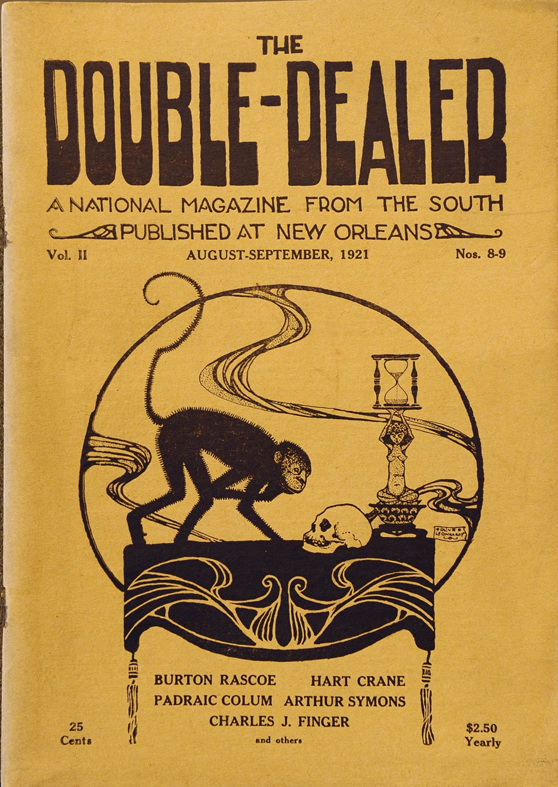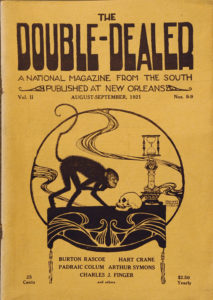Poetry
Louisiana poetry ranges from early francophone works to contemporary compositions.

Courtesy of The Historic New Orleans Collection.
Cover of a 1921 issue of The Double Dealer.
Like Louisiana culture in general, Louisiana poetry is varied and multifaceted, reflecting the state’s mix of cultures and traditions. Though poets have always called the state home, New Orleans’s status as a literary and cultural center during the era of modernism played a particularly important role in the development of the genre. As rich as Louisiana’s poetic tradition is, the state’s profusion of distinguished and accomplished contemporary poets may be as impressive as anything in its literary past.
Antebellum Poetry
The first published works of poetry written in the Louisiana territories are credited to Julien Poydras de Lallande. Along with poetic tributes to the Spanish governor, Poydras wrote a lyrical account of a battle for the Baton Rouge bluffs entitled “La Prise du Morne du Baton Rouge,” published in 1779. The most influential “poetry” of Louisiana’s earliest days, though, was oral rather than written, embodied in Creole folk songs that were passed down through generations. Louisiana’s multicultural folk tradition included songs written in the unique dialects of the area—notably Cajun French and Creole—that were printed in eighteenth and nineteenth Louisiana periodicals. Eventually, many were published in anthologies like Slave Songs of the United States (1867). The transcriptions of these songs influenced Louisiana writers such as George Washington Cable, Lafacadio Hearn, and Grace King, and played an important role in the development of local color fiction. The influence of the state’s folk traditions can still be seen in the flourishing field of contemporary Louisiana poetry
In the early to middle nineteenth century, the first real flowering of written poetry in Louisiana took place, much of it produced by free people of color. One of the most important figures of this era was Armand Lanusse, a free black man who was both a poet and an activist. Serving as principal of New Orleans’ Catholic School for Indigent Orphans of Color, he was also instrumental in publishing some of the first African American writing in Louisiana. In 1843, Lanusse and J. L. Marciacq founded L’Album Littéraire: Journal des Jeunes Gens, Amateurs de la Littérature!, which featured poetry and other writings by free people of color.
Lanusse also compiled an important anthology of poetry by Louisiana writers of color: Les Cenelles. The first published anthology of African American verse, Les Cenelles included Lanusse’s own poems, as well as works by seventeen other black poets. Among the most notable was Camille Thierry, who wrote verse in French about both typically Romantic themes and issues of race and place. Joanni Questy, too, was a prominent poet and contributor to Les Cenelles. His work was often overtly political, as in his 1867 poem “Aux Conservateurs,” which criticized conservative opponents of Reconstruction.
Other poets of the era included the brothers Dominique and Adrien Rouquette. Both were romantic poets, though their lives and styles differed considerably. Dominique’s two volumes of poetry, Les Meschacbeennes (or “The Mississippians”) and Les Fleurs D’Amerique, were well-received overseas, particularly in France. While Dominique was known for his penchant for debauchery, his brother Adrien became a priest who ministered to Choctaw Indians near New Orleans. His poetry was chiefly about nature and explored themes he examined at length in his novel, La Nouvelle Atala, which celebrated Indian life.
Louisiana Poetry after the Civil War
Most critics and literary historians agree that Louisiana literature came into its own in the decades immediately following the Civil War. Just as women wrote much of the era’s most notable Louisiana fiction, female authors wrote much of the most significant poetry. French Creole poet Leona Queyrouze, who wrote primarily in French and under pseudonyms, wrote not only poetry, but symphonies as well, two of which were performed at the 1884 World Exposition in New Orleans. Eliza Jane Nicholson published her first poems in 1867. She went on to publish in a variety of journals and newspapers including the New Orleans Times and the New Orleans Picayune, where she served as literary editor beginning in 1870. In addition to being a successful poet, she and her husband are credited with leading the once-troubled Picayune into prosperity. In 1867, Mollie Moore Davis published the popular Minding the Gap and Other Poems, a volume of poetry she had composed during the Civil War. She, too, had a connection with the New Orleans Picayune; her husband, Thomas E. Davis, served as Editor-in-Chief. Mary Ashley Townsend, who made a reputation writing under the pen-name “Xariffa,” and Martha Field, who wrote poetry and travel writings under the pen name “Catharine Cole,” were two other prominent poets of the period.
Louisiana Poetry and Modernism
The dawn of literary modernism saw New Orleans, already a cultural and literary center in the South, come to national and international prominence as a hub that both produced and hosted some of the most important writers and poets of the era. The short-lived but influential literary magazine The Double Dealer, founded in 1921, was at the center of the literary modernist movement in New Orleans, and published works by such notable poets as Robert Penn Warren, Allen Tate, Donald Davidson, Djuna Barnes, Hart Crane, and many others. Warren along with Cleanth Brooks, his colleague in the English department at Louisiana State University (LSU), also profoundly shaped the way poetry was read and understood by developing a new methodology for the study of literature: New Criticism. Emphasizing the importance of close textual readings—as opposed to either the biography of the author or the cultural and historical context—New Criticism dominated the study of American literature from the 1920s through the early 1960s.
African American poets of the 1930s and 1940s found an outlet in a section of the African American newspaper The Louisiana Weekly called “Poets’ Corner.” Writer Marcus Christian served as poetry editor of that publication. During the same period, Alexandria-born poet, author, and literary critic Arna Bontemps became a prominent figure in the Harlem Renaissance, a flowering of African American art, literature and culture that took place in New York during the 1920s. Bontemps won the Alexander Pushkin poetry prize in two consecutive years, 1926 and 1927. He went on to have a long and distinguished literary career, publishing fiction, poetry, and criticism into the 1970s.
Modern and Contemporary Louisiana Poetry
The flowering of Louisiana poetry has continued in recent years, much of it written by people of color. In the late 1960s and 1970s, Tom Dent, an African American writer whose poetry collections include Magnolia Street (1972) and Blue Lights and River Songs (1982), spearheaded a movement to encourage, develop, and define black art and literature in the South. This movement, which developed through organizations such as the Free Southern Theater, BLKARTSOUTH, and the Congo Square Writers Workshop, enabled and encouraged black Louisiana writers to create and publish. This movement, along with poetry and literary journals such as the New Orleans Poetry Journal and The Outsider, encouraged the development of a vital community of contemporary poets in Louisiana.
One of the most famous and contemporary Louisiana-born poets is Yusef Komunyakaa, who grew up in Bogalusa before serving in the Vietnam War. His experience in that conflict inspires and informs a good deal of his poetry. His work is distinguished, in part, by his use of colloquial voice, and the influence of musical forms, particularly jazz. Komunyakaa has published several collections of poems, one of which–the 1993 volume Neon Vernacular–won the Pulitzer Prize for poetry.
Many prominent contemporary poets address aspects of Louisiana culture in their work. Sybil Kein ‘s poetry focuses on Creole language and culture. Her poems are usually written in a combination of standard English and Creole French. Brenda Marie Osbey, whose collection of poems entitled All Saints won the American book award in 1998, also deals with Creole culture and representations of New Orleans in her works. Pinkie Gordon Lane, who holds the distinction of being the first African American woman to receive a doctoral degree from LSU, also evokes a strong and distinctive sense of place in her poetry, and was appointed Poet Laureate for the state of Louisiana in 1989. Other notable contemporary Louisiana poets include Ralph Adamo, Alvin Aubert, Quo Vadis Gex-Breaux, Lee Meitzen Grue, Maxine Cassin, Mona Lisa Saloy, and Peter Cooley.
